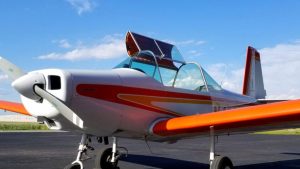Please join us this Thursday, September 21st from 4 – 5 p.m. for the CSA Flight & Drone Simulators and Aircraft!
CSA Facilitators are excited to offer learners the thrill of flight in pilot-quality simulators next door at Exploration of Flight (EoF)! The simulators recreate the experience of flight, giving participants a very realistic feel for the environment inside a cockpit. However, this won’t be possible without assistance from our CSA parents and community. We require four parent volunteers per class visit at EoF. That will require 4 parents a day per week if they’re able to stay for both class visits per grade or 8 parents a day per week. Parent volunteers will likely assist with setup, a brief orientation, and flight.
The simulators and aircraft available to CSA learners will be:
FlyThisSim TouchTrainer® FM210: Engineered to be introduced in the first stages of a pilot’s aviation experience, the TouchTrainer FM 210 flight simulator provides an immersive dual-seat cockpit. It includes pilot/co-pilot intercoms, complete audio simulation, and an on-board instructor’s station. The massive 64 square feet of wrap-around visual display will keep you coming back for more. Each learner’s experience in the TouchTrainer FM210 is 10 minutes in length with a 5-minute orientation.
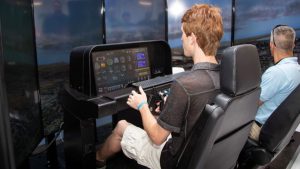
Beechcraft T-34 Mentor: Walter Beech originally developed the T-34 Mentor as the Beechcraft Model 45, a general aviation aircraft after World War II, a period when the US military had an excess of training aircraft. The aircraft saw use in the late 1940s in Japan, Spain, several South American countries, and Turkey. The US Air Force purchased 450 T-34As with over 1,450 built by companies in other countries such as Fuji Heavy Industries of Japan and FMA of Argentina for local use. In 1954, the US Navy purchased over 420 T-34Bs.
The US Air Force moved away from the T-34 in the late 1950’s switching to the T-37 jet trainer with the US Navy favoring the T-6 Texan II by the mid-1980s. Wings Over the Rockies’ Model T-34A ‘Mentor’ was previously owned and flown by the Lima Airshow Team, hence the LL21 designation on its right wing.
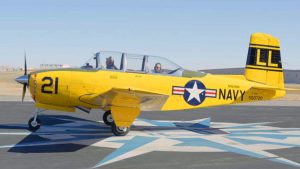
North American SNJ-5 Texan: Designed as a transition trainer between basic trainers and first-line tactical aircraft, the SNJ trained several hundred thousand pilots in over 30 different countries over a period of 25 years. North American Aviation built 15,495 planes between 1938 and 1955. Considered a “pilot’s airplane,” it was designed to give the best possible training in all types of tactics, from ground strafing to bombardment and aerial dog fighting.
This SNJ-5 flew with the US Navy from 1943 through 1958 from Naval Air Stations in Texas, Louisiana, Florida, and New Jersey. It has been civilian-owned since.
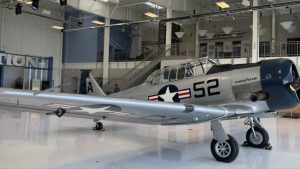
Tecnam P2010: Tecnam is an Italian airplane manufacturer founded in 1986, and was the result of the sale of the original airplane manufacturing company, Partenavia to the Italian government. Partenavia was founded by two aviation enthusiast brothers Luigi “Gino” Pascale, and Giovanni “Nino” Pascale in 1950 after some success with their P55 Tornado aircraft which won the Giro di Sicilia race in 1950. The Pascale brothers’ first aircraft, the P48 Astore was built in their garage in Via Tasso in 1948.
The Tecnam P2010 is a four-seat, high-wing, single-engine light general aviation aircraft combining a composite propeller, metal wings, and tailplane on a composite fuselage with an integrated fin. The aircraft was first shown in public at the 2011 AERO Friedrichshafen Airshow and took its first flight in April 2012. Tecnam sold 30 units at AERO in 2011.
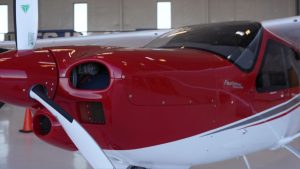
Varga 2150A Kachina: In the 1950s, William J. Morrissey designed an airplane inspired by the trainer aircraft of WWII, featuring tandem seating and a center joystick. The aircraft construction rights were sold to Shinn Engineering Inc. and later to the Varga Aircraft Corporation in 1965. Based in Chandler Arizona, Varga christened the aircraft “Kachina,” named for the spirits of the local Hopi tribe. Varga’s model included a larger engine, generating 150hp. This gave the 2150A superior performance to competing two-seat aircraft of the era.
Varga ceased production in 1982, among the many general aviation manufacturers which went out of business in the 1980s. There are 83 aircraft still registered in the United States. Of the surviving examples, several reside in Colorado. The aircraft at Wings Over the Rockies is vintage 1977 with factory original paint and upholstery. This plane offers low operating costs with exceptional style, great for first-time flyers and sightseeing. The 2150A is the smallest aircraft in the Wings Over the Rockies fleet; passenger height and weight limitations are nonnegotiable for flight safety.
